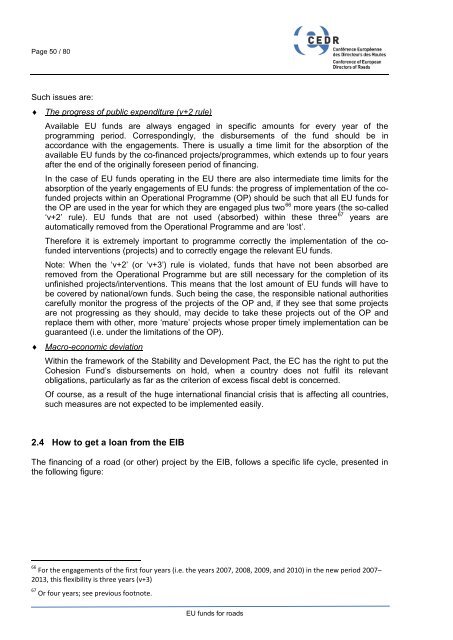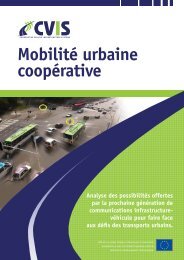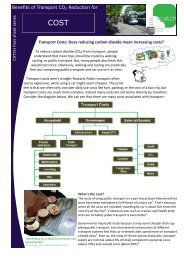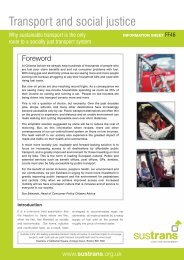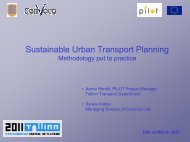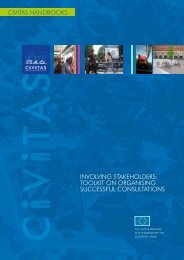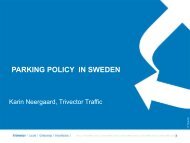EU funds for roads - CEDR
EU funds for roads - CEDR
EU funds for roads - CEDR
You also want an ePaper? Increase the reach of your titles
YUMPU automatically turns print PDFs into web optimized ePapers that Google loves.
Page 50 / 80<br />
Such issues are:<br />
♦<br />
♦<br />
The progress of public expenditure (v+2 rule)<br />
Available <strong>EU</strong> <strong>funds</strong> are always engaged in specific amounts <strong>for</strong> every year of the<br />
programming period. Correspondingly, the disbursements of the fund should be in<br />
accordance with the engagements. There is usually a time limit <strong>for</strong> the absorption of the<br />
available <strong>EU</strong> <strong>funds</strong> by the co-financed projects/programmes, which extends up to four years<br />
after the end of the originally <strong>for</strong>eseen period of financing.<br />
In the case of <strong>EU</strong> <strong>funds</strong> operating in the <strong>EU</strong> there are also intermediate time limits <strong>for</strong> the<br />
absorption of the yearly engagements of <strong>EU</strong> <strong>funds</strong>: the progress of implementation of the cofunded<br />
projects within an Operational Programme (OP) should be such that all <strong>EU</strong> <strong>funds</strong> <strong>for</strong><br />
the OP are used in the year <strong>for</strong> which they are engaged plus two 66 more years (the so-called<br />
‘v+2’ rule). <strong>EU</strong> <strong>funds</strong> that are not used (absorbed) within these three 67 years are<br />
automatically removed from the Operational Programme and are ‘lost’.<br />
There<strong>for</strong>e it is extremely important to programme correctly the implementation of the cofunded<br />
interventions (projects) and to correctly engage the relevant <strong>EU</strong> <strong>funds</strong>.<br />
Note: When the ‘v+2’ (or ‘v+3’) rule is violated, <strong>funds</strong> that have not been absorbed are<br />
removed from the Operational Programme but are still necessary <strong>for</strong> the completion of its<br />
unfinished projects/interventions. This means that the lost amount of <strong>EU</strong> <strong>funds</strong> will have to<br />
be covered by national/own <strong>funds</strong>. Such being the case, the responsible national authorities<br />
carefully monitor the progress of the projects of the OP and, if they see that some projects<br />
are not progressing as they should, may decide to take these projects out of the OP and<br />
replace them with other, more ‘mature’ projects whose proper timely implementation can be<br />
guaranteed (i.e. under the limitations of the OP).<br />
Macro-economic deviation<br />
Within the framework of the Stability and Development Pact, the EC has the right to put the<br />
Cohesion Fund’s disbursements on hold, when a country does not fulfil its relevant<br />
obligations, particularly as far as the criterion of excess fiscal debt is concerned.<br />
Of course, as a result of the huge international financial crisis that is affecting all countries,<br />
such measures are not expected to be implemented easily.<br />
2.4 How to get a loan from the EIB<br />
The financing of a road (or other) project by the EIB, follows a specific life cycle, presented in<br />
the following figure:<br />
66 For the engagements of the first four years (i.e. the years 2007, 2008, 2009, and 2010) in the new period 2007–<br />
2013, this flexibility is three years (v+3)<br />
67 Or four years; see previous footnote.<br />
<strong>EU</strong> <strong>funds</strong> <strong>for</strong> <strong>roads</strong>


